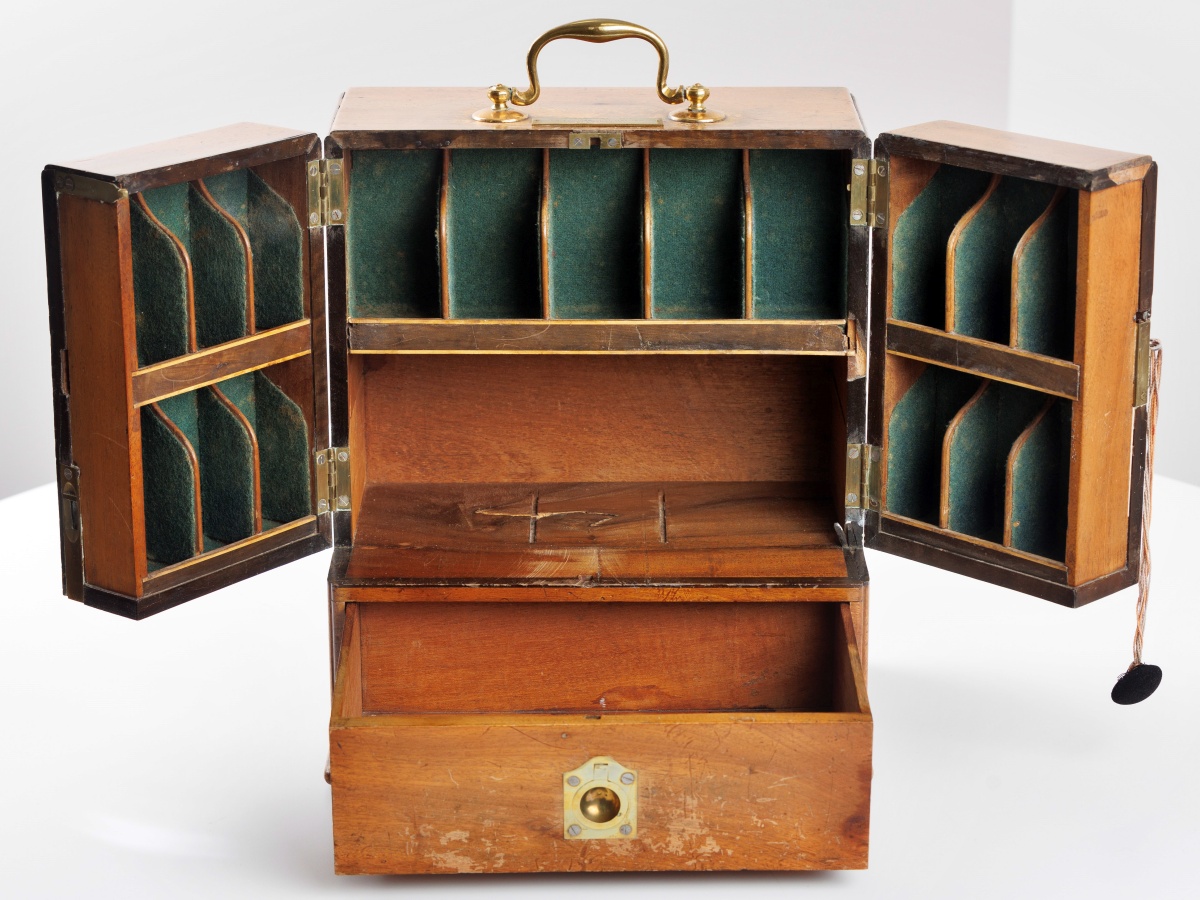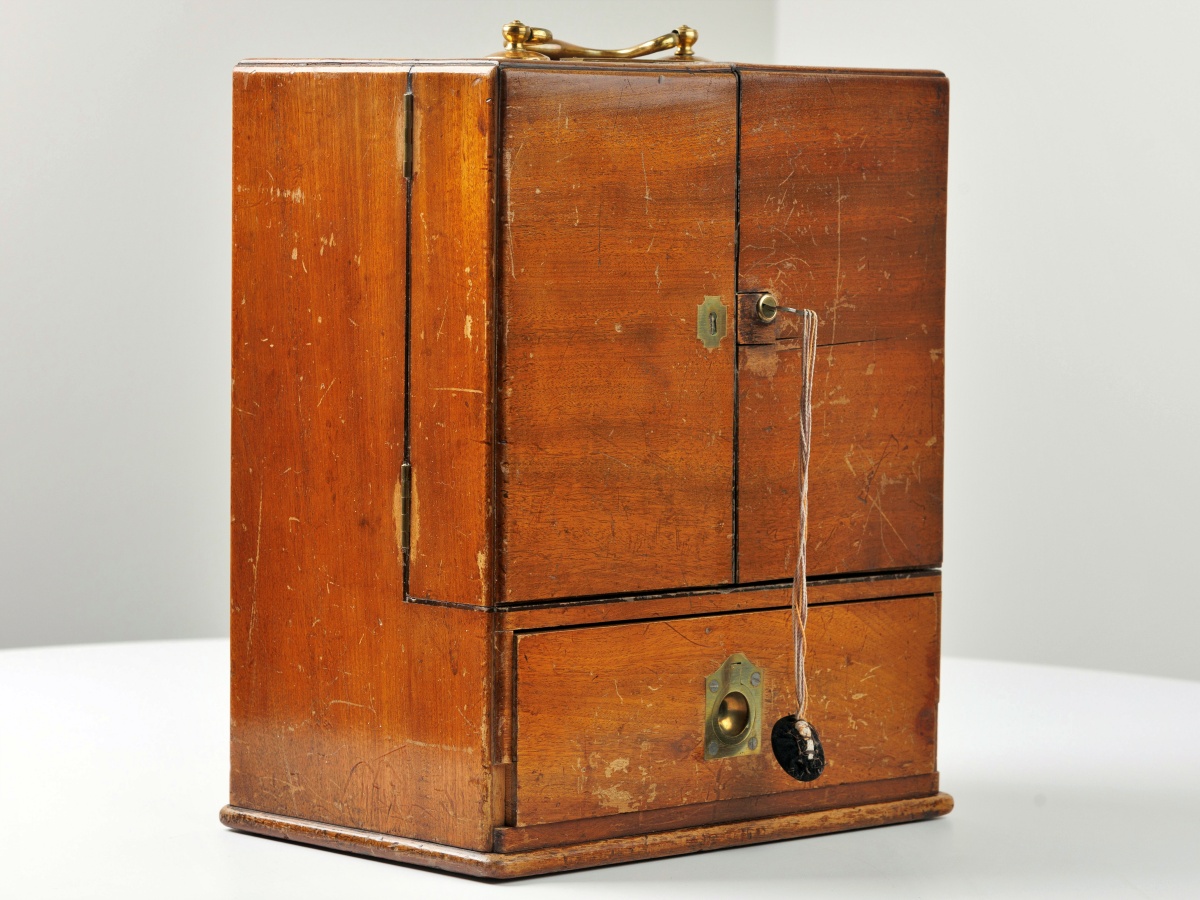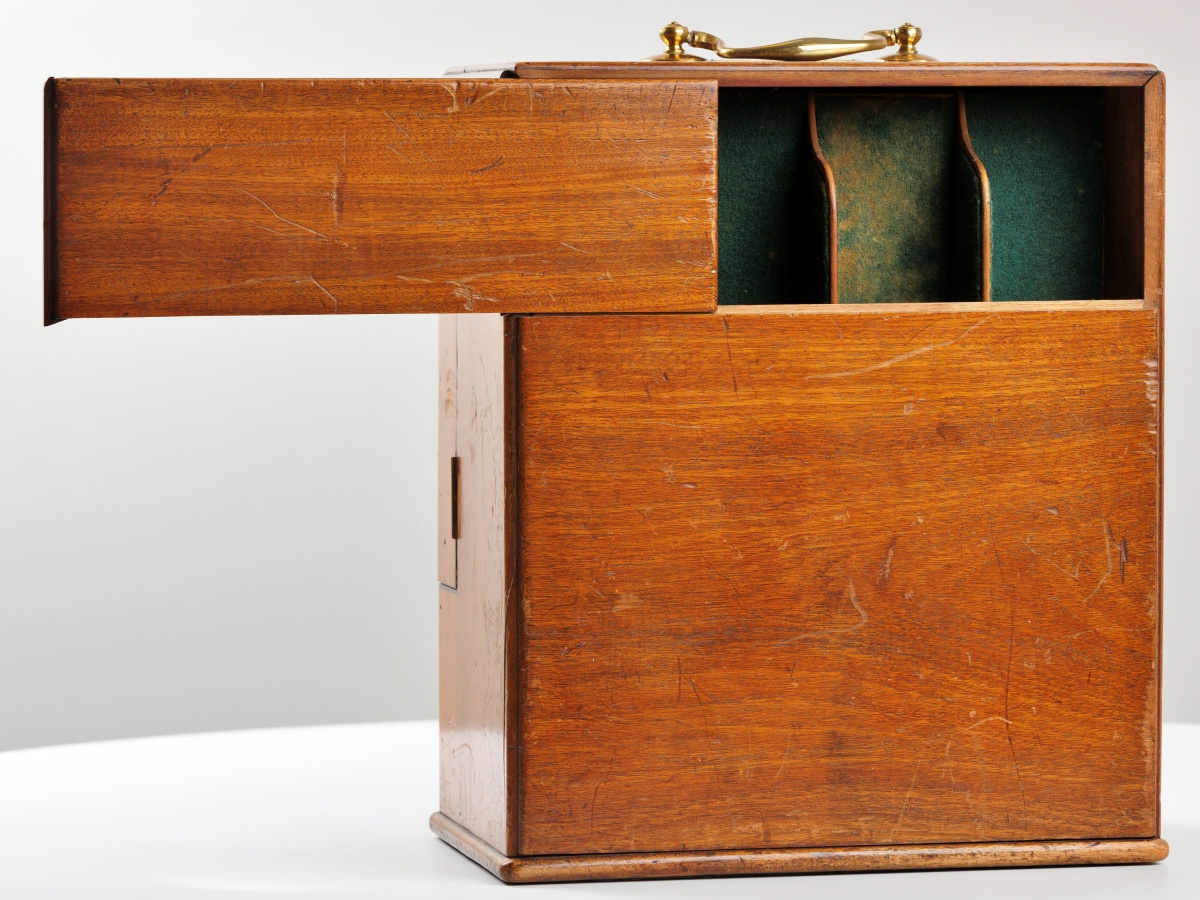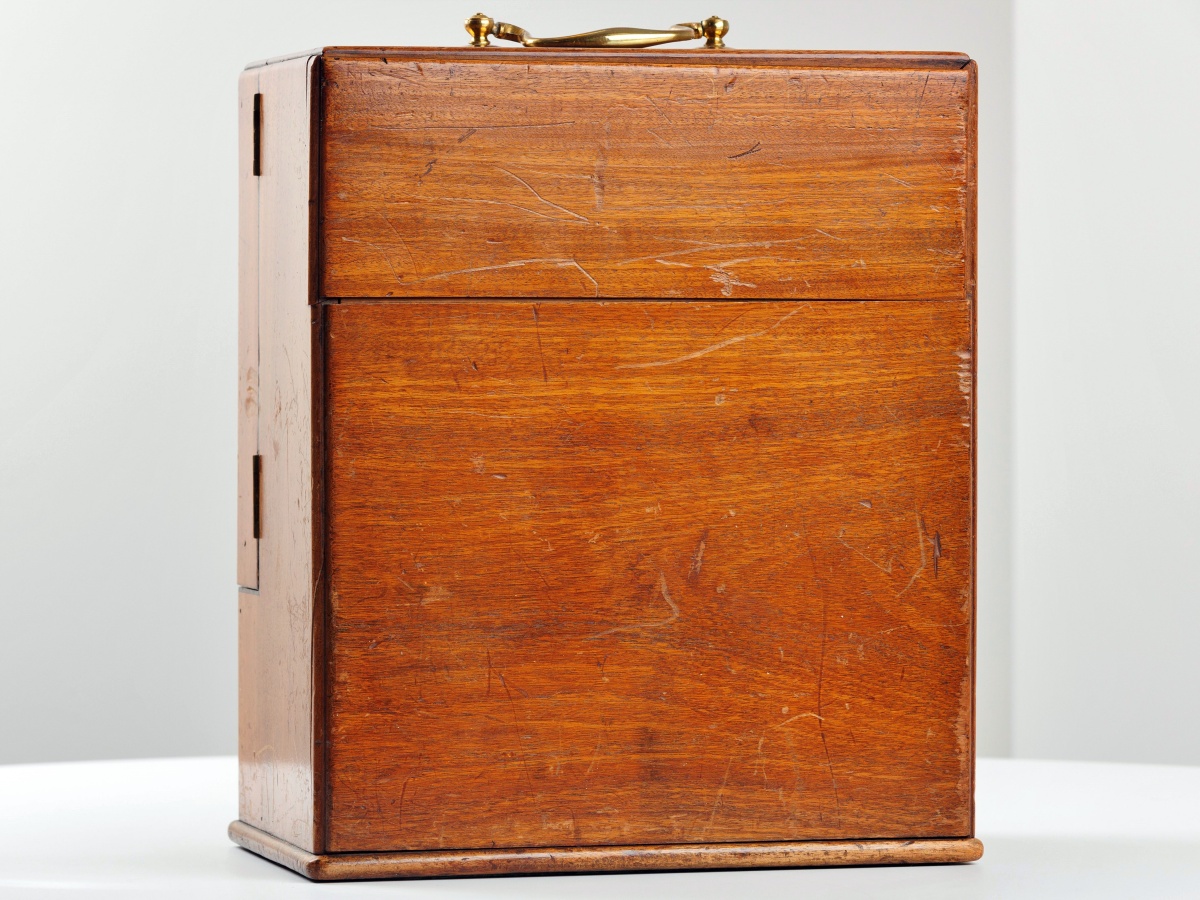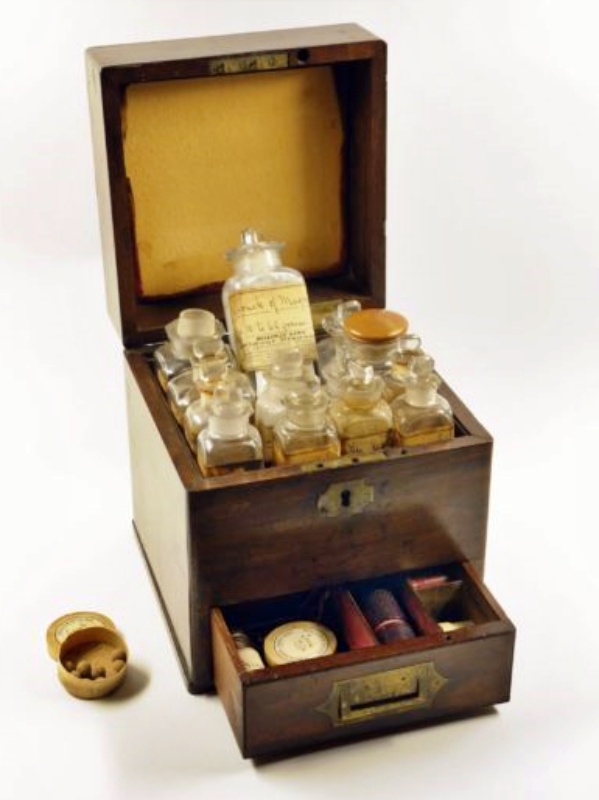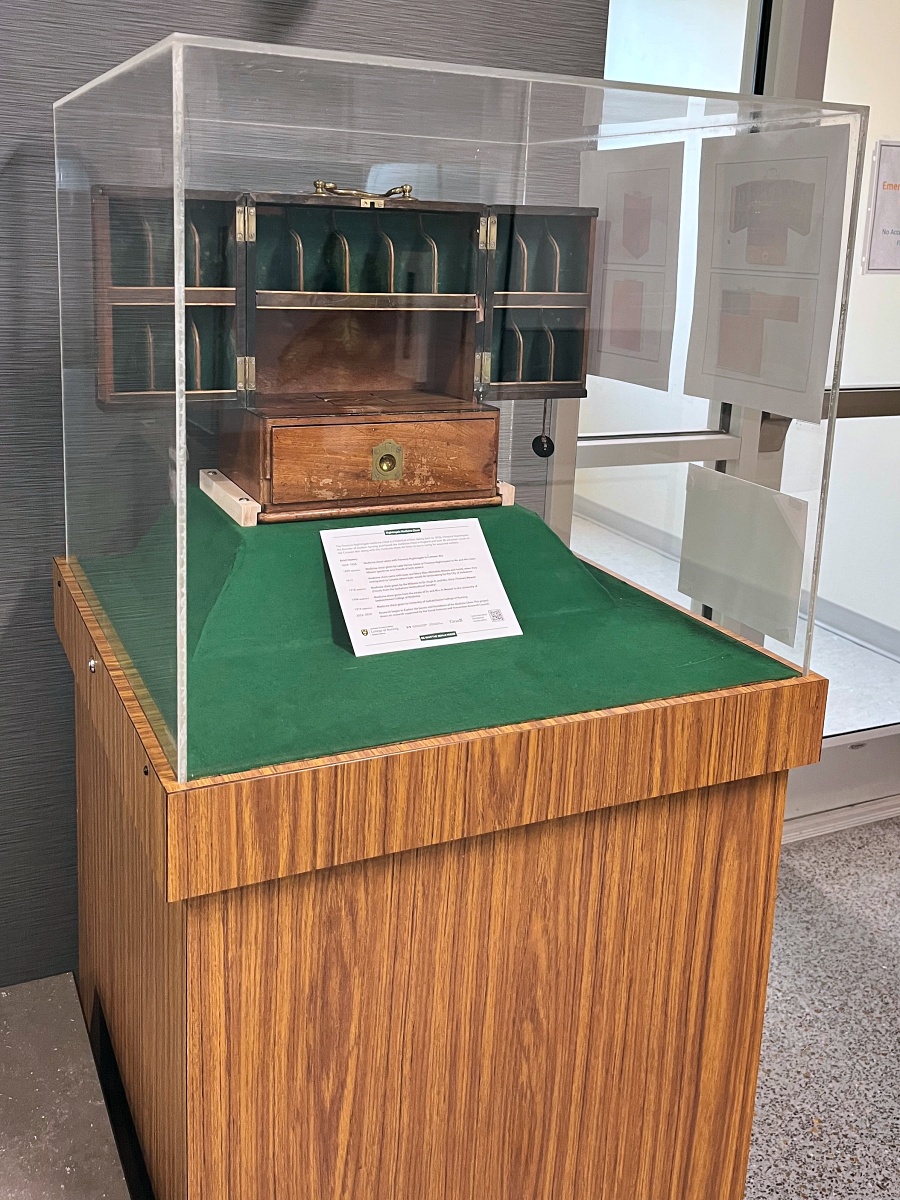Introduction
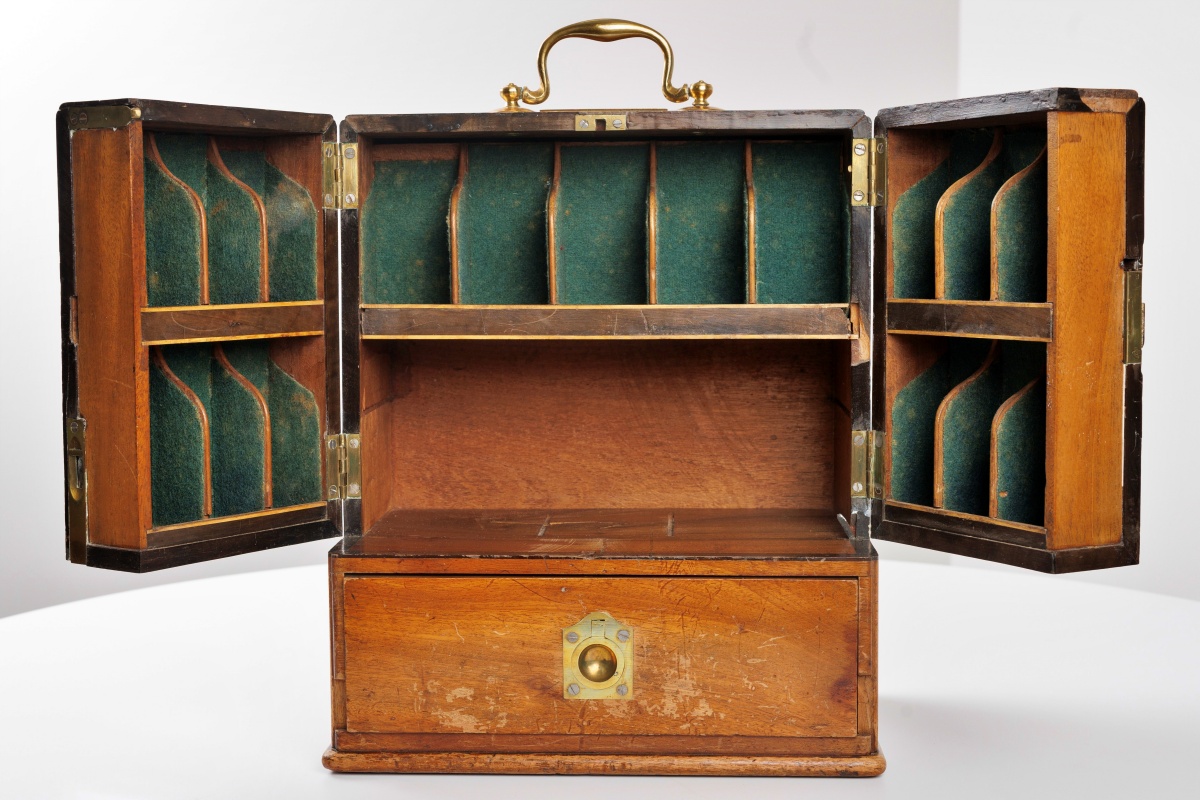
The Florence Nightingale medicine chest is a historical artifact dating back to 1850’s. Florence Nightingale was a nurse who became known as ‘The Lady with the Lamp’, and made innovative health care policy changes (managing and training nurses) during the Crimean War.
Florence Nightingale is credited as the founder of modern nursing. Nightingale purchased the medicine chest in England and took 38 volunteer nurses to the Crimea, along with the medicine chest, for them to use in caring for wounded soldiers.
The medicine chest came to Canada in 1912 and was donated to the University of Saskatchewan around 1956.
About Florence Nightingale (1820 - 1910)
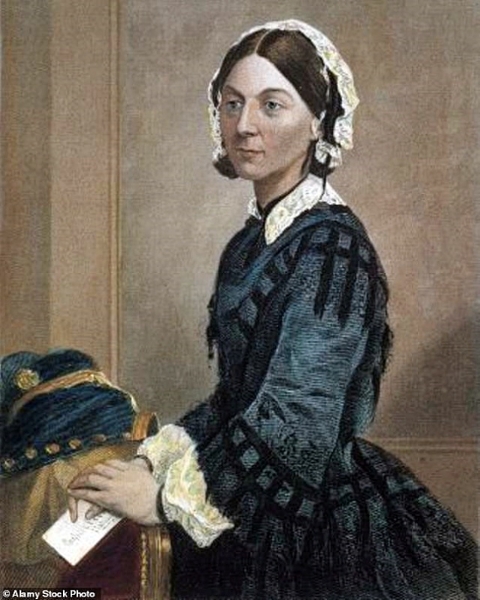
Florence Nightingale, OM, RRC, DStJ (12 May 1820 –13 August 1910) was a British nurse, English social reformer, statistician, and the founder of modern nursing (National Archives, 2023).
Nightingale gave nursing a favorable reputation, especially in the persona of "The Lady with the Lamp". She became the nurse known as the "The Lady with the Lamp", due to reports of her compassionate care of wounded soldiers, when making rounds at night with her lamp.
Introduction Video
PDF (PPT) Presentations 1-5
- Presentation 1: Nightingale Medicine CHEST
- Presentation 2a: Florence Nightingale LIFE
- Presentation 2b: Florence Nightingale LEGACY
- Presentation 3: Nightingale Medicine Chest CUSTODIANS
- Presentation 4: Nightingale Medicine Chest RESEARCH
- Presentation 5: Nightingale Medicine Chest FUTURE
1820
Florence Nightingale was born in Florence, Italy, on May 12, 1820 when her wealthy parents from England were there on an extended vacation. Florence was named after the city where she was born (Florence Nightingale Museum [FNM], 2023d).1830s
In her teenage years, Florence discovered a talent for nursing while caring for her family and their servants during a flu epidemic. Florence felt she had a vocation for a profession that was not well respected by her affluent and well-connected family and friends (Preston, 2020).1844
Nightingale’s father eventually gave Florence permission to go to Germany in 1844 to receive training as a nurse in a hospital in Kaiserwerth, Germany. Nightingale’s first experience of ward work occurred during her three-month stay in Kaiserwerth with the Protestant Deaconesses, who managed a school, orphanage, and hospital (FNM, 2023p).1853
In 1853, Nightingale secured the role of Superintendent of the Establishment for Gentlewomen During Illness in London, England (FNM, 2023c).1854 – 56
Florence Nightingale went to Istanbul, Turkey in Fall 1854 to run the military hospital in €Usk€udar (old Scudari) and care for the Turkish and allied soldiers during the Crimean War (McDonald, 2019). When Nightingale arrived in the Crimea with 38 volunteer nurses, they found horrific, unsanitary conditions in a disorganized, overcrowded, military hospital system with a high mortality of soldiers. Florence found more soldiers were dying from typhoid, cholera, and dysentery than from war injuries (British Broadcasting Centre [BBC], 2020; McDonald 2019; Panos, 2020).1858
Florence Nightingale became the first female member of the Royal Statistical Society in 1858. She was able to explain in diagram form that most of the deaths recorded in army hospitals came from disease, rather than from battle wounds and that disease could be controlled by good nutrition. Known as a rose diagram, but commonly called ‘coxcomb’, this graph, which resembles a pie chart, was designed by Nightingale with the help of William Farr. It highlights the number of unnecessary deaths during the Crimean War as a result of preventable infections. It has become Nightingale’s most well-known statistical illustration (FNM, 2023b).1859
Nightingale wrote Notes on Nursing (Nightingale, 1859; 1960). The book served as the cornerstone of the curriculum at the Nightingale School and other nursing schools, though it was written specifically for the education of those nursing at home (Nightingale, 1959; FNM, 2023j). Nightingale’s book ‘Notes on Nursing: What it Is and What it is Not’, was translated into numerous languages and became an international best-seller. This guide to looking after sick people at home was written in simple, direct language so any reader could understand it. The book includes many practical tips from hand washing, to preparing foods, to how carers should behave towards their patient.1860
Nightingale founded the first official nurses' training programme called the Nightingale School & Home for Nurses at St Thomas’ Hospital in London, England (National Archives, 2023). It is now called the Florence Nightingale Faculty of Nursing and Midwifery at King's College London on the St. Thomas Hospital Campus (King College London, 2020).1870s
Nightingale advocated autonomous nursing leadership, and her new style of matrons had full control and discipline over their nursing staff.1883 – 1908
Nightingale received several awards and honors. In 1883, Nightingale became the first recipient of the Royal Red Cross; in 1904, she was appointed a Lady of Grace of the Order of St John (LGStJ); in 1907, she became the first woman to be awarded the Order of Merit; in the following year she was given the Honorary Freedom of the City of London (Wikipedia, 2023a).1893
The Nightingale Pledge created in 1893, was named after Nightingale as the founder of modern nursing. The Nightingale Pledge is a statement of the ethics and principles of the nursing profession, which nurses recite at their pinning ceremony at the end of training. The Nightingale Pledge is a modified version of the Hippocratic Oath (Wikipedia, 2023a).1910
Florence Nightingale died peacefully in her sleep in London, on August 13, 1910, at the age of 90 (Wikipedia, 2023a). Until her death, Nightingale encouraged the development in nursing in Britain and abroad. She educated people about the importance of keeping hospitals clean and free from infection, and this work is carried on today in modern hospitals.1965
Since 1965, International Nurses Day has been celebrated on her birthday (May 12) each year(Wikipedia, 2023a).
1989
The Florence Nightingale Museum (FNM) opened in 1989 in London, England. This museum celebrates the life, work, and legacy of the best known figure in nursing history, with a collection of over 3000 exhibits (FNM, 2023q). The FNM (2023h) features a medicine chest (or box) that is smaller than the medicine chest in Canada.2020
Nurses Week in May 2020 celebrated 100 years since the birth the founder of modern nursing Florence Nightingale.A Look at the Florence Nightingale Medicine Chest
The medicine chest is made of dark brown wood, possibly mahogany, and has double opening front doors. On the inside of each door are six partitions or cubicles with six more partitions across the top of the back wall within the open chest. Each individual cubicle is lined with green baize. There is one single drawer spanning the width of the chest beneath the double doors.
At the back of the medicine chest is a secret compartment that opens by a sliding wood panel. Inside of which could have been concealed the dangerous drugs and poisons of the day!
The medicine chest is only in fair condition, as it appears to have been well-used in its time.
How was the medicine chest used?
Nightingale took medicine chests (like the one in Canada pictured above and the medicine chest or box displayed at the Florence Nightingale Museum below) to the Crimea. Most of the medicines in it were for treating gastric complaints, and many were highly toxic if used inappropriately.
Paregoric Elixir had painkilling properties, but was largely used as an anti-diarrhea remedy, while Aromatic Confection was seen as a tonic that could also purge the system of trapped wind. Essence of Ginger, Citric Acid, Powdered Rhubarb and Carbonate of Magnesia and Soda were used to relieve flatulence and spasms of the stomach and bowels. She also carried quinine for malaria, and Carbonate of Potassium for fever.
Current Chest Location
The Florence Nightingale medicine chest is housed at the University of Saskatchewan College of Nursing. It has been in Saskatoon, SK, Canada since 1912 and at the University of Saskatchewan since about 1956.
The Nightingale medicine chest has been in many locations over the years, but the five-foot display case is currently located in the Health Sciences Building E-Wing 4th floor.
Florence Nightingale Medicine Chest in Canada
1854 – 56
Florence Nightingale bought the chest in London, England. She brought 38 volunteer nurses with her to the Crimea. The assumption was she also brought medicine chests with her to use in caring for the wounded soldiers. Florence often paid for hospital supplies from her own money (Preston, 2020); therefore, it is reasonable that she could have bought two or more medicine chests for her many nurses, as they would need more than one in caring for the soldiers (Kent-Wilkinson, 2021).1890
Lady Verney (Florence’s sister) gave this medicine chest to her gardener Mr. Isaac Milsom. Mr. & Mrs. Milsom were friends of the Nightingale sisters (CoN archives: Brown et al., 2008). Mr. Milsom was head gardener at Claydon House, where Lady Verney lived. Florence Nightingale often stayed at Claydon House in the summers (FNM, 2023n).1912
Isaac and Mary Ellen Milsom immigrated to Canada in 1912 with most of their seven children (Census of Canada, 2016) and the Florence Nightingale medicine chest. This was long after Lady Verney had passed away and two years after Florence Nightingale had passed in 1910.1914
Isaac Milsom was hired to do landscaping for the City of Saskatoon. Soon after arriving in Saskatoon, Saskatchewan, Mr. Milsom met and became friends with Dr. Hugh Dalton Weaver, who was also originally from England (Saskatoon Daily Star, 1914).1917
Mary Ellen Milsom passed away in 1917. An article in the Saskatoon Daily Star (1917) revealed Mrs. Milsom had been highly educated at Trinity College in Dublin, Ireland and Oxford University in England, but had also had been a friend of Florence Nightingale.1918
In 1918, after his wife passed, Isaac went to Regina for a short time (Saskatoon Star Phoenix, 1918) then to Philadelphia, PA. Around this time, it is believed Mr. and Mrs. Milsom gave the medicine chest to their friends Dr. and Mrs. Hugh D. Weaver.1940
A Nurse’s Tea was held at the Hudson’s Bay Store in downtown Saskatoon. The successful event, attended by over 300 people, featured on display the Florence Nightingale Medicine Chest. Owners of the chest at that time were Dr. and Mrs. H. D. Weaver (Saskatoon Daily Star, 1940).1956
Sometime around 1956, the medicine chest was donated by the Weaver estate to the University of Saskatchewan College of Medicine. Dr. Weaver passed in 1942 and his wife Alice in 1954 (CoN Archives: Brown et al., 2008; Saskatoon Daily Star, 1942; 1954).1974
Around 1974, the medicine chest was given to the College of Nursing at the University of Saskatchewan.1989
The Florence Nightingale Museum (FNM) opened in 1989 in London, England. The FNM features a medicine chest or box (FNM, 2023h) that is much smaller than the medicine chest in Canada. Another exhibit at the FNM showcases personal items that once belonged to Florence Nightingale, with this description: “A piece of lace, a purse, and brooch that belonged to Florence… Parthenope distributed locks of Florence’s hair to close friends and family” (FNM, 2021c). This notation, that Lady Verney often gifted her sister’s possessions to family and friends, provides collaborating evidence that Lady Verney did often give some of Florence’s possessions to friends, and for how this larger medicine chest may have come to end up at a very distant location, in Canada. She may have thought the Milsons could use it for their many children.Today
The Medicine Chest has been in Canada for well over 100 years (1912) and for over 60 years (1956) at the University of Saskatchewan.Research on the Medicine Chest
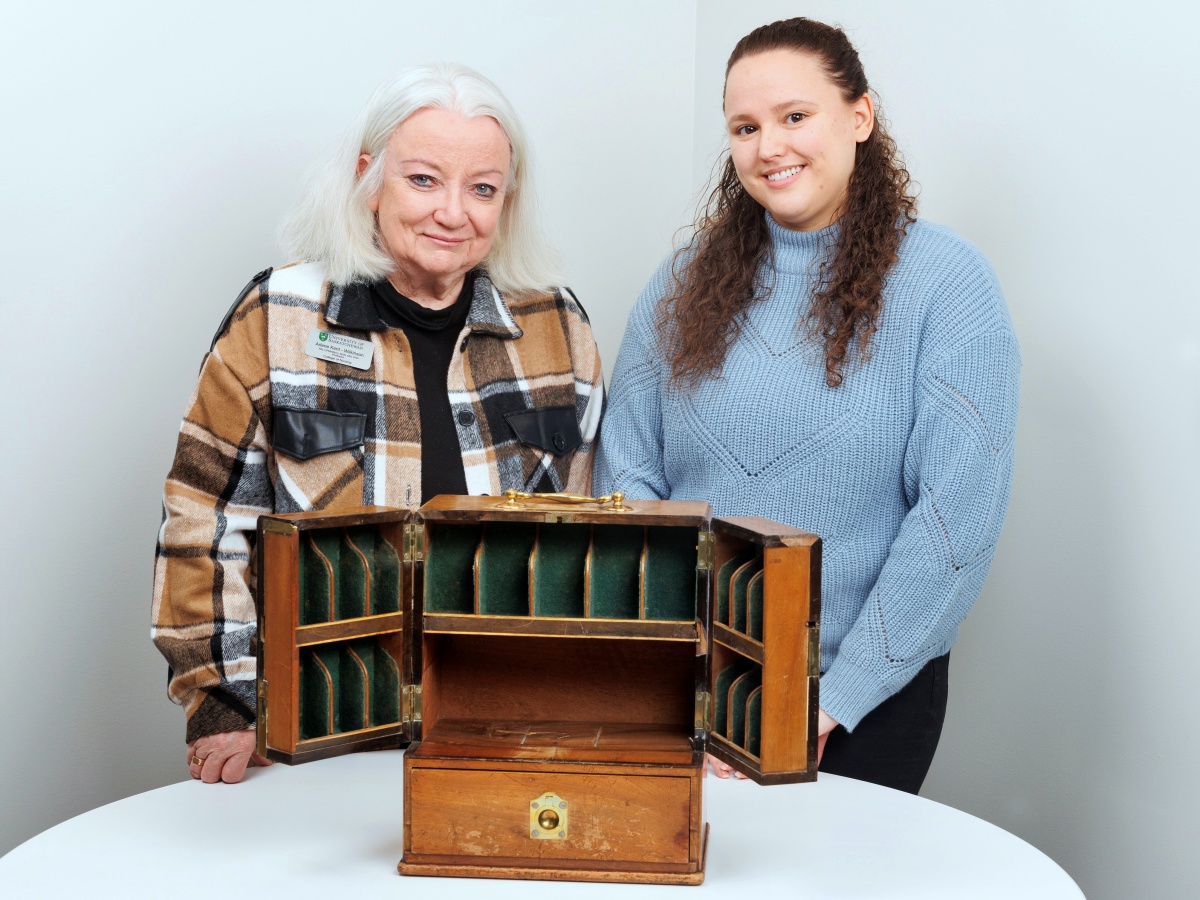
The Florence Nightingale medicine chest has been waiting for decades for research to be conducted on this historical artifact.
A research project titled, Explore the Secrets and Provenance of the Florence Nightingale Medicine Chest in Canada, is currently underway by University of Saskatchewan College of Nursing researchers Dr. Arlene Kent-Wilkinson (RN, PhD), Dr. Helen Vandenberg (RN, PhD) and PhD candidate with the Department of History Letitia Johnson.
See recent article Research continues on historical nursing artifact (University of Saskatchewan, 2025, April 29).
This project draws on research supported by the Social Sciences and Humanities Research Council.

Test Your Knowledge
1) What year was Florence Nightingale born?
- 1819
- 1820
- 1854
- 1854
2) Who/What was Florence Nightingale named after?
- Her mother, Frances
- Lady with the Lamp
- Florence, Italy
- Naples, Italy
3) What three things was Florence Nightingale a British nurse most famous for?
- English social reformer, statistician, and the founder of modern nursing
- American social reformer, dietician, and the Lady with the Lamp
- English social reformer, librarian, and the founder of modern nursing
- American social reformer, feminist, and the Lady with the Lamp
4) Florence Nightingale took 38 volunteer nurses and medicine chest(s) to which war?
- War of 1812
- Crimean War (1854-1856)
- Boer War (1899-1902)
- World War I (1912-1914)
5) Where in the World is Florence Nightingale’s Medicine Chest?
- Florence, Italy
- Istanbul, Turkey
- London, England
- Saskatoon, SK, Canada
6) What year did the Medicine Chest arrive in Canada?
- 1820
- 1910
- 1912
- 2020
7) What is one secret about the Florence Nightingale’s Medicine Chest (cabinet itself)?
- best kept secret
- secret society
- secret compartment
- secret recipe
Publications/References
Academic
Brown, Y. M. R., Smith, B. L., & Brown, F. B. (2008). 70 years of nursing education 1938–2008 at the University of Saskatchewan. College of Nursing, University of Saskatchewan, Saskatoon, SK., Canada. [See Ch. 9, p. 195, information regarding medicine chest in College archives].
Kent-Wilkinson, A. (2021, May 26). Where in the world is the Florence Nightingale medicine chest? International Nursing Review, 68(2), 166–171.
http://dx.doi.org/10.1111/inr.12678
https://onlinelibrary.wiley.com/doi/epdf/10.1111/inr.12678
Newspaper – Saskatoon Daily Star/ Saskatoon Star Phoenix
Custodians of Nightingale Chest Saskatoon Daily Star. (1914, July 28). TWO day’s flower show this year. Saskatoon Horticultural and Arboricultural Association (p. 6). (Article links Dr. H. Weaver's name with Isaac Milsom). 28_Jul_1914__6_-_Star-Phoenix_at_Newspapers.com.pdf
https://www.newspapers.com/image/507540440
Saskatoon Daily Star. (1917, September 15). Mrs. Milsom had famous friends in old country.
Saskatoon Star Phoenix. (1918, April). Isaac Milsom goes to Regina. [2020-225-SP-1918-00-04].
Saskatoon Star Phoenix. (1933, May 15). Dead: Capt. Isaac Milsom. [2020-225-SP-1933-05-15].
Saskatoon Star Phoenix. (1940, January 18). Advertisement invitation to Nurse’s Tea on Friday,
Jan 19, 1942. [2020-225-SSP-1940-01-18].
Saskatoon Star Phoenix. (1940, January 20). Exhibit owned by Florence Nightingale at Nurse’s Tea Friday: Successful function arranged in aid of Red Cross in Hudson’s Bay Company Store attracts many visitors. The Women’s Page (p. 8). [2020-225-SSP-1940-01-20].
Saskatoon Star Phoenix. (1942, September 14). Death takes Dr. Weaver: Pioneer physician dies after brief illness- here since 1905. Dr H. D. Weaver. [2020-225-SP-1942-09-14] Saskatoon Star Phoenix. (1954, November 29). Mrs. H. D. Weaver dies in Halifax. [2020-225-SP-1954-11-29]
Saskatoon – City of Saskatoon Archives
City of Saskatoon Archives. (2020). Weaver Park, 1954. Park locations & amenities.
https://www.google.com/maps/d/viewer?mid=1i2jw1tjUk9ac6QLUug58zbo6bPlSajJd&ll=52.121124559976124%2C-106.64710741793823&z=13
University of Saskatchewan - College of Nursing
Kent-Wilkinson, A. (2022, May 12). Florence Nightingale medicine chest: Historic medicine chest located at the University of Saskatchewan. Nurses Week May 9–15, 2022, College of Nursing, University of Saskatchewan.
https://nursing.usask.ca/news/2022/20220512florence-nightingale-medicine-chest.php
University of Saskatchewan - On Campus News
Shewaga, J. (2009, March 27). Campus oddities: Remembering a great Victorian. On Campus News. University of Saskatchewan.
https://wayback.archive-it.org/3890/20210112041452/https://ocnarchives.usask.ca/09-mar-27/campus_oddities.php
Shewaga, J. (2019, December 13). Uniquely USask: Western Canada's first X-ray machine. On Campus News. University of Saskatchewan.
https://news.usask.ca/articles/general/2019/uniquely-usask-western-canadas-first-x-ray-machine.php
Shewaga, J. (2020, September 11). Uniquely USask: Florence Nightingale’s medicine chest. On Campus News. University of Saskatchewan.
https://news.usask.ca/articles/general/2020/uniquely-usask-florence-nightingales-medicine-chest.php
University of Saskatchewan – Photo Contest – Research in Action
Kent-Wilkinson, A., Vandenberg, H., & Johnson, L. (2023, March 7). 100 years of Secrets to Reveal: Florence Nightingale Medicine Chest at USask. Research in Action. Images of Research, 2023 Competition.
https://usask.wishpondpages.com/research-in-action-2023/entries/201839536
Kent-Wilkinson, A. (2025, January 6). Nightingale Medicine Chest in Canada Introduction Video [Youtube: 10:41 minutes]. College of Nursing, University of Saskatchewan, Saskatoon, SK.
https://youtu.be/55lsYne3DKo
University of Saskatchewan. (2025). Historical Florence Nightingale Medicine Chest in Canada.
College of Nursing, USask, Saskatoon Campus, SK.
Historical Florence Nightingale Medicine Chest
University of Saskatchewan. (2025, April 29.). Research continues on historical nursing artifact at USask (by Kylie Kelso). Green & White, College of Nursing, University of Saskatchewan
Research continues on historic nursing artifact at USask
British Broadcasting Company. (2020, September 11). A history of the world-objects: Florence Nightingale’s medicine chest.
https://www.pinterest.ca/pin/559642691175321059/
Brown, Y. M. R., Smith, B. L., & Brown, F. B. (2008). 70 years of nursing education 1938–2008 at the University of Saskatchewan. College of Nursing, University of Saskatchewan, Saskatoon, SK., Canada. [See Ch. 9, p. 195, information regarding medicine chest in College archives].
Census of Canada. (1916). Isaac & Mary Ellen Milsom.Census of Manitoba, Saskatchewan and Alberta.
Florence Nightingale Museum. (2023a). Choosing a Life without Marriage [Display No. 73]. Exhibits from ‘Florence the woman’, Florence Nightingale 200 years.
https://www.florence-nightingale.co.uk/suitors/
Florence Nightingale Museum. (2023b). ‘Coxcomb’ diagram, 1858 [Display no 55]. Exhibits from ‘Statistician and evidence based health care’, Florence Nightingale 200 years.
https://www.florence-nightingale.co.uk/coxcomb-diagram-1858/
Florence Nightingale Museum. (2023c). Establishment for gentlewomen during illness, Harley Street, London [Display No. 56]. Exhibits from ‘Florence the woman’, Florence Nightingale 200 years.
https://www.florence-nightingale.co.uk/harley-street
Florence Nightingale Museum. (2023d). Florence, Italy [Display No. 68]. Exhibits from ‘Florence the woman’, Florence Nightingale 200 years.
https://www.florence-nightingale.co.uk/florence/
Florence Nightingale Museum. (2023e). Florence Nightingale’s Lamp, 19th century [Display No. 94]. Exhibits from ‘Florence the woman’, Florence Nightingale 200 years.
https://www.florence-nightingale.co.uk/fanoos/
Florence Nightingale Museum. (2023f). Frances, Nightingale, 1788–1880 [Display No. 122]. Exhibits from ‘Florence the woman’, Florence Nightingale 200 years.
https://www.florence-nightingale.co.uk/frances-nightingale-1788-1880/
Florence Nightingale Museum. (2023g). Jimmy the tortoise, 19th century [Display No. 69]. Exhibits from ‘Florence the woman’, Florence Nightingale 200 years.
https://www.florence-nightingale.co.uk/jimmy-the-tortoise/
Florence Nightingale Museum. (2023h). Medicine chest [Display No. 28]. Exhibits from ‘Florence the woman’, Florence Nightinhgale 200 years.
https://www.florence-nightingale.co.uk/medicine-chest/
Florence Nightingale Museum. (2023i). Nightingale in 200 objects, people & places. Florence Nightingale 200 years.
https://www.florence-nightingale.co.uk/200objects/
Florence Nightingale Museum. (2023j). Notes on nursing, 1860 by Florence Nightingale [Display 138]. Exhibits from ‘Florence the woman’, Florence Nightingale 200 years.
https://www.florence-nightingale.co.uk/notes-on-nursing/
Florence Nightingale Museum. (2023k). Our collections.
https://www.florence-nightingale.co.uk/history-of-the-collection/
Florence Nightingale Museum. (2023l). Parthenope Nightingale, 1819-1890 [Display No. 163]. Exhibits from ‘Florence the woman’, Florence Nightingale 200 years.
https://www.florence-nightingale.co.uk/parthenope-nightingale-1819-1890/
Florence Nightingale Museum. (2023m). Photo:Before and after,Scutari Hospital, Turkey [Display No. 71]. Exhibits from ‘Florence the woman’, Florence Nightingale 200 years.
https://www.florence-nightingale.co.uk/scutari-hospital/
Florence Nightingale Museum. (2023n). Photograph of Florence Nightingale at Claydon [Display No. 104]. Exhibits from ‘Florence the woman’, Florence Nightingale 200 years.
https://www.florence-nightingale.co.uk/claydon/
Florence Nightingale Museum. (2023o). Stay at Florence’s childhood home at Lea Hurst.
https://www.florence-nightingale.co.uk/stay-at-florences-childhood-home-in-lea-hurst/
Florence Nightingale Museum. (2023p). The Deaconess Institute, Kaiserwerth, Germany [Display No. 44]. Exhibits from ‘Florence the woman’, Florence Nightingale 200 years.
https://www.florence-nightingale.co.uk/kaiserwerth/
Florence Nightingale Museum. (2023q). Welcome to the Florence Nightingale Museum.
https://www.florence-nightingale.co.uk/
Kent-Wilkinson, A. (2021, May 26). Where in the world is the Florence Nightingale medicine chest? International Nursing Review, 68(2), 166–171.
http://dx.doi.org/10.1111/inr.12678
https://onlinelibrary.wiley.com/doi/epdf/10.1111/inr.12678
King College London. (2020). St. Thomas’ campus.
https://www.kcl.ac.uk/visit/st-thomas-campus
McDonald, L. (2019). Florence Nightingale. A reference guide to her life and works. Rowman & Littlefield.
National Archives. (2023). Florence Nightingale Why do we remember her
https://www.nationalarchives.gov.uk/education/resources/florence-nightingale/#:~:text=Florence%20Nightingale%20(1820%2D1910),the%20founder%20of%20modern%20nursi
Nightingale, F. (1859). Notes on nursing, 1859: What it is and what it is not? Harrison & Sons.
Nightingale, F. (2017). Notes on nursing. What it is and what it is not? First published in 1860. Los Angeles: Enhanced Media.
Panos, K. (2020). Florence Nightingale: The lady with the data. Hackaday.
https://hackaday.com/2020/02/04/florence-nightingale-the-lady-with-the-data
Saskatoon Star Phoenix. (2017, August 11). Gardening: A short history of the Saskatoon Forestry Farm Park and Zoo – Part II (by Bernadette Vangool)
https://thestarphoenix.com/life/bridges/gardening-a-short-history-of-the-saskatoon-forestry-farm-park-and-zoo-part-ii
Shewaga, J. (2019, December 13). Uniquely USask: Western Canada's first X-ray machine. On Campus News. University of Saskatchewan.
https://news.usask.ca/articles/general/2019/uniquely-usask-western-canadas-first-x-ray-machine.php
Shewaga, J. (2020, September 11). Uniquely USask: Florence Nightingale’s medicine chest. On Campus News. University of Saskatchewan.
https://news.usask.ca/articles/general/2020/uniquely-usask-florence-nightingales-medicine-chest.php
Wikipedia. (2023a). Florence Nightingale.
https://en.wikipedia.org/wiki/Florence_Nightingale
Wikipedia. (2023b). Frances Parthenope Verney.
https://en.wikipedia.org/wiki/Frances_Parthenope_Verney


